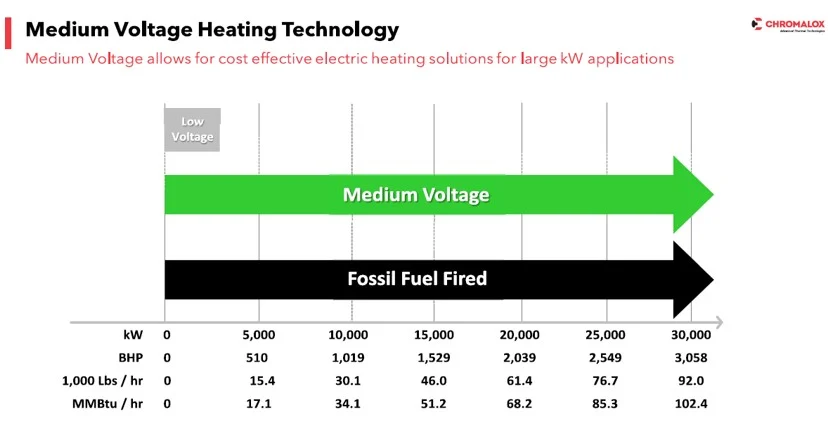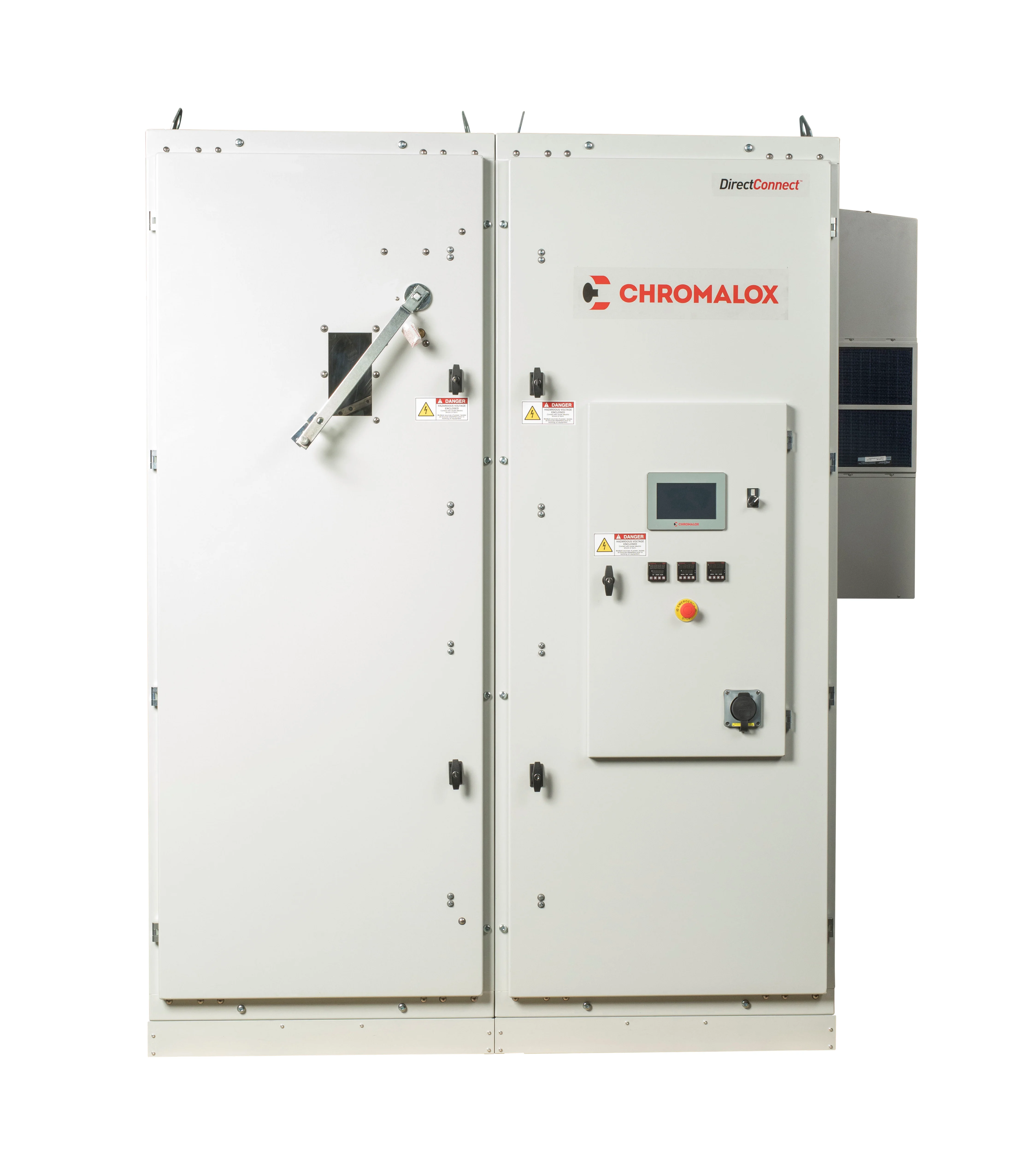Process heating electrification: Total cost benefits beyond reduced carbon emissions
April 13, 2023
In 2023, there is significant concern over the environmental impact of carbon emissions, with industry representing one of the chief worldwide CO2 emitters. This has led to a concerted push for decarbonization in this arena, and more specifically in process heating, which has traditionally been accomplished via the combustion of carbon-producing fuel sources.
While it may be a cost-effective and powerful heating method, burning fossil fuels is a significant source of CO2. However, it has disadvantages well beyond emissions in the form of permitting costs, inefficiencies, maintenance requirements and turndown ratios that mean heating can’t be cycled on and off at will. With increasing regulatory burdens, along with fuel and maintenance costs, these disadvantages will likely become even more onerous in the coming years and decades.
The alternative to combustion process heating is to use electric heating. While traditional low-voltage systems can’t always satisfy the energy demands of large-scale heating processes, Chromalox’s medium voltage (MV) DirectConnect heating technology makes electrification practical in a much larger range of situations.

Figure 1: DirectConnect Medium Voltage technology. Source: Chromalox
Electric heating cost justification and total cost of ownership
The cost of electric heating is typically higher than combustion on simple dollars-per-energy input basis, but this is far from the full story. Regulations-wise, the cost of carbon offsets can be significant depending on jurisdiction, and even where it’s not, the overall trend is in this direction. Installing electric industrial heaters future-proofs processes, so that as these costs increase in the future, the effects can be mitigated. Depending on future developments, this may even give an enterprise a competitive advantage.
Beyond regulatory carbon costs, electrification presents a number of practical benefits and total cost of ownership (TCO) savings. In terms of energy input per energy used in processing, electricity is nearly 100% efficient. Resistive “losses” in a heater are what produce a thermal input, meaning that what loss there is comes in switching and resistance in wiring before the heating element. Electric heating can be applied to liquid applications like oil or steam and hot water generation, heating gases and temperature management applications.
Electric heating also benefits from lower maintenance and installation costs when compared to its fossil fuel counterparts. No dangerous open flames are present to create a safety hazard for personnel. Electric heaters can also produce heat when and where it’s needed – with the ability to turn on and shutdown extremely quickly and not be dependent on low turn down burners or additional excess air compositions. This makes electric systems ideal for dynamic processes in addition to base load applications.
There are also no purging losses, nor is heat lost directly out of the flue as it is with combustion processes. No spent gas needs to be ejected from an operation, so flue losses, or even the need to construct one, aren’t a consideration. As such, there are no direct emissions or air permits to consider, another regulatory cost independent of actual CO2 emissions.
Medium voltage unlocks additional heating potential
Electric heating is more efficient on an energy input basis than using fossil fuels. However, using traditional low voltage sources (under 1,000 V AC) limits the maximum amount of energy that can be added to a process. DirectConnect Medium Voltage technology (using 1,000 V AC to 7,200 V AC input without a transformer) from Chromalox allows electric heating to be used on a much larger scale, where low voltage heating would be impractical.

Figure 2: Medium voltage heating technology chart. Source: Chromalox
The advantage of using a higher voltage for heating comes down to the most basic of electrical engineering equations: power equals voltage times current, P = VI. For a given system power requirement, as the voltage increases, the current decreases proportionally. Since cable diameter requirements are dependent on the current supplied, not the voltage, lower current therefore means fewer or smaller cables and connectors.
For example, consider that a 2 MW system running at 415 V would require a massive 2,786 amp supply. An equivalent 2 MW system running at 6.6 kV would only require 175 amps.
The caveat to higher voltage operation is that cable insulation must be correspondingly robust to stand up to this electric potential. Chromalox tests their MV elements beyond the standard requirements of IEC for a robust design that exceeds any real-world scenario that may be experienced. For a system at 480 V, Chromalox products again adhere to the strict requirements of IEC, ensuring a high degree of safety in either situation.
Electric heaters are not just a solution to eliminate a facilities Scope 1 emissions but can be synergized with the adoption of renewable energy sources like wind, solar or hydro. Whether using MV DirectConnect technologies, or more traditional low voltage (LV) heating implementations, either can be used with solar or other renewable sources with the addition of an AC inverter. The inverter transforms the DC power obtained from sources like a solar array into AC current. This can then power processes with entirely emission-free heating, eliminating scope two emissions generated at the energy provider.
Medium voltage heating
Consider a process that requires a 3,230 kW heating solution. Fossil fuel fired heating would be the standard choice for this sort of application as it is at the fringe of what a low-voltage electric heating system would traditionally be practical for. MV electrical heating, however, is a perfect choice for this task.
If plant engineers were to go with an LV 380 V solution, the process to generate 3,230 kW of power would require 4,900 amps, and conventionally 63 circuits to handle the load. In contrast, a 6,600 V MV solution would require only 280 amps and a mere two circuits for the same amount of power. Current demand is thus reduced by a factor of over 17, saving 61 circuits worth of wire, contactors, fusing and installation labor. All told, upfront cost savings total over $800,000 to $1,753,000 for the LV option, versus $907,600 for the 6,600 V installation. Note that while total equipment costs for the 6,600 V solution are somewhat higher than for 380 V, installation expenses are dramatically reduced.
Beyond installation, operating and ongoing maintenance costs of the MV system over its lifetime are greatly reduced. Here this works out to an annualized savings of $252,810, or upwards of $5 million over a 20-year equipment lifespan. While this compares MV and LV options — both available from Chromalox — comparing the different factors that may affect overall electric versus fossil fuel technologies, plus specific fluid, gas or freeze protection equipment options can be a daunting task. To get a full grasp of all options, it can be helpful to solicit outside expertise.

Figure 3. Chromalox has been in the electric heating space for over a century. Source: Chromalox
A century of electric heating experience at your disposal
While the conversion of oil and gas heating to electric is under consideration perhaps more than at any other time before, Chromalox has been in the electric heating space for over a century. They developed many fundamental technologies that make this type of heating possible. As such, they are perfectly positioned to help with process heating electrification upgrades, as well as systems designed for electrification from the ground-up.
Upon request, Chromalox personnel can visit a facility to perform a decarbonization assessment. From there, they can present different options and alternatives to fossil fuel-based heating systems, evaluating whether a full replacement is called for, or if existing equipment can be retrofitted with electric heaters. Chromalox can quantify energy efficiency improvements and carbon reduction savings based on solutions proposed, arming customers with raw numbers to help justify new capital costs.
Chromalox
Chromalox was founded in 1917 and is headquartered in Pittsburgh, Pennsylvania. They employ 1,250 people worldwide, with a global manufacturing and support footprint. Their goal today, as in the beginning, is to develop innovative new products and technologies to meet their customers’ evolving needs, including the transition from fossil fuel to electric heating. Product offerings include industrial heaters and systems, component technologies, and heat trace for freeze protection and thermal maintenance.
Information and programs provided by admin@mcmassociates.io.